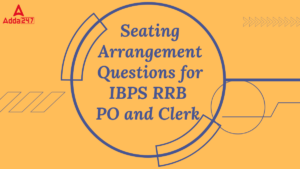Dear Aspirants,
Reasoning Ability is an onerous section. With the increasing complexity of questions, it becomes hard for one to give it the cold shoulder. The only way to make the grade in this particular section in the forthcoming banking exams is to practice continuously with all your heart and soul. And, to let you practice with the best of the latest pattern questions, here is the Adda247 Reasoning Quiz based on the exact same pattern of questions that are being asked in the exams.
Directions (1-5): Study the following information carefully and answer the questions given below:
Seven farmers sold seven different fruit in four different months i.e. March, June, September and November in a same year. At least one person but not more than two persons sold fruits in each of these months. Each of them sold different fruits viz. Litchi, Orange, Mango, Guava, Pineapple, Grapes and Banana. D neither sold Orange nor Grapes. Mango was not sold by F. G sold guava in the month of September. Mango was not sold in the month of November. Neither C nor E sold Mango. F sold fruit in the month of June. B sold fruits in the month of June. E did not sell grapes. Mango and Litchi were sold in the same month. A sold banana in the month of March. Guava was sold in September. Only one person sold fruit in the month of March. Orange and Pineapple were sold in the same month. E did not sell fruits in the month of September. D sold fruits in November.
Q1. Which of the following fruit was sold in the month June?
(a) Litchi
(b) Mango
(c) Pineapple
(d) Both Litchi and Mango
(e) None of these
Q2. Who among the following person sold fruits in the same month as D?
(a) C
(b) E
(c) Either G or E
(d) G
(e) None
Q3. Orange and Pineapple were sold in which of the following months?
(a) March
(b) June
(c) November
(d) November and September
(e) None of these
Q4. Which of the following persons sold fruits in the same month as G?
(a) D
(b) A
(c) C
(d) E
(e) None of these
Q5. Which of the following fruits were sold by A, C and E respectively?
(a) Banana, Grapes and Orange
(b) Banana, Orange and Pineapple
(c) Banana, Pineapple and Litchi
(d) Banana, Litchi and Orange
(e) None of these
Direction (6-10): Study the following information to answer the given questions.
In a certain code language,
‘loud of Speaker minister’ is written as `ga gmo til su’
‘hard false loud promise on’, is written as ‘kil zo gmo ye na’
‘minister false political energy’ is written as `zo ra til da’
and ‘political conclude of promise’ is written as `da ga nic kil’.
Q6. What is the code for ‘on’?
(a) ye
(b) na
(c) zo
(d) Either na or zo
(e) Either ye or na
Q7. What does `su’ stand for?
(a) minister
(b) loud
(c) of
(d) Speaker
(e) None of these
Q8. What is the code for ‘energy loud conclude’?
(a) nic ye til
(b) gmo ra nic
(c) ra ga gmo
(d) da ra nic
(e) None of these
Q9. Which of the following does `kil til na’ stand for?
(a) promise of loud
(b) hard loud promise
(c) minister promise hard
(d) minister promise on
(e) Either (c) or (d)
Q10. Which of the following may represent ‘beyond limits of loud’?
(a) ga zo til da
(b) ga ba gmo nee
(c) ga ba nic kil
(d) gmo ba til ra
(e) None of these
Directions (11-15): In each question below are given three statements followed by four conclusions numbered I, II, III and IV. You have to take the given statements to be true even if they seem to be at variance with commonly known facts. Read all the conclusions and then decide which of the given conclusions logically follows from the given statements, disregarding commonly known facts:
Q11. Statements:
a. All shoes are laces.
b. No lace is ink.
c. All ink are tigers.
Conclusions:
I. Some laces are shoes.
II. All laces are shoes.
III. Some tigers are laces.
IV. All tigers are ink.
(a) Only II and IV follow
(b) Only either I or II follows
(c) Only either III or IV follows
(d) All follow
(e) None of these
Q12. Statements:
a. Some pinks are sinks.
b. All sinks are cages.
c. Some cages are not pinks.
Conclusions:
I. Some cages are pinks.
II. All pinks are cages.
III. All sinks are pinks.
IV. All cages are pinks.
(a) None follows
(b) Only I follows
(c) Only I and II follow
(d) Only II and III follow
(e) All follow
Q13. Statements:
a. Some bus are trucks.
b. All trucks are trains.
c. Some trains are cars.
Conclusions:
I. Some trains are bus.
II. Some cars are bus.
III. Some cars are trucks.
IV. Some trucks are bus.
(a) None follows
(b) Only IV follows
(c) Only I follows
(d) Both I and IV follow
(e) All follow
Q14. Statements:
a. All pillows are rice.
b. Some sauces are rice.
c. All pens are sauces.
Conclusions:
I. Some sauces are pillows.
II. Some pens are rice.
III. Some rice are pillows.
IV. No pen is rice.
(a) Only either II or IV and III follow
(b) Only either II or IV and I follow
(c) Only either I or II and IV follow
(d) None follows
(e) All follow
Q15. Statements:
a. All ducks are bull.
b. No bull is a flower.
c. All flowers are fruits.
Conclusions:
I. No duck is a flower.
II. Some fruits are flowers.
III. Some bulls are ducks.
IV. Some ducks are flowers.
(a) All follows
(b) Only either I or II and both III and IV follow
(c) Only either I or IV and both II and III follow
(d) Only either I or IV and II follow
(e) None of these






 GA Capsule for SBI Clerk Mains 2025, Dow...
GA Capsule for SBI Clerk Mains 2025, Dow...
 The Hindu Review October 2022: Download ...
The Hindu Review October 2022: Download ...
 Seating Arrangement Questions for IBPS R...
Seating Arrangement Questions for IBPS R...





